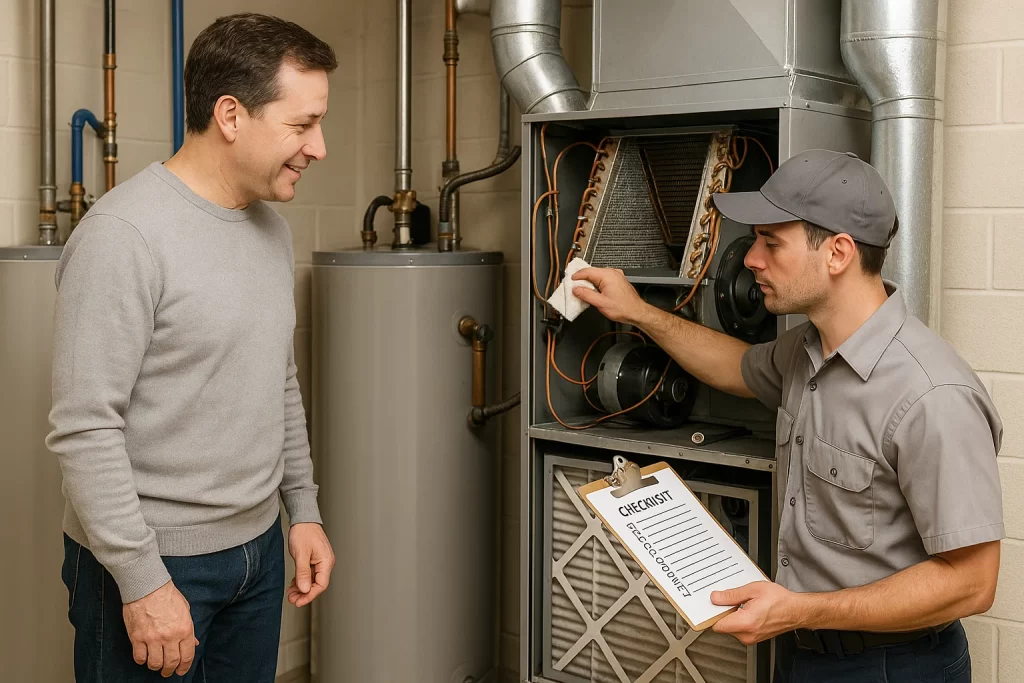When it comes to maintaining a heating, ventilation, and air conditioning system, or really any complex mechanical system, it’s crucial to understand the different stages of care it requires over time.
Two common terms you’ll hear us talk about are performance maintenance and preventative maintenance. While they may sound similar, they serve different purposes and are applicable at different stages in the life of your equipment. Knowing the difference can help you make better decisions, extend the life of your system, and save money on repairs.

The First 10 Years: Performance Maintenance
During the first decade of your HVAC system’s life, maintenance is largely about preserving optimal performance. This is known as performance maintenance. At this stage, the equipment is relatively new, and its components are in good working condition. The goal of performance maintenance is to keep everything running like new—efficiently, quietly, and reliably.
Think of performance maintenance like regular checkups and tune-ups for a high-performance vehicle. Technicians clean, calibrate, and inspect critical components to ensure your system maintains peak energy efficiency and comfort output. This includes checking refrigerant levels, cleaning coils, tightening electrical connections, and verifying that airflow is properly balanced.
By keeping the system finely tuned, performance maintenance helps prevent early wear and tear, reduces your energy bills, and ensures you get the full value out of your initial investment.
Beyond 10 Years: Preventative Maintenance
Once your system hits the 10-year mark, it enters a new phase of care—preventative maintenance. At this point, your HVAC equipment has likely endured a fair share of wear, and the focus shifts from optimizing performance to preventing problems. Preventative maintenance is designed to reduce the likelihood of breakdowns, minimize repair costs, and extend the system’s lifespan. Older systems especially benefit from annual HVAC maintenance checks to stay ahead of wear and avoid mid-season failures.
During preventative maintenance, technicians prioritize inspections for aging or worn components. They may proactively replace parts that are showing signs of deterioration, lubricate moving parts to prevent friction damage, and monitor signs of corrosion or fatigue. This form of maintenance is less about performance metrics and more about risk management.
Preventative maintenance is especially important for older systems because the likelihood of mechanical failure increases with age. Without it, you may face costly repairs or even premature system replacement. With it, you gain peace of mind knowing your aging system is being cared for strategically to squeeze out as many more years of reliable service as possible.
Why the Distinction Matters
Understanding the difference between performance and preventative maintenance allows homeowners to set appropriate expectations for their HVAC care plans. Early in your system’s life, your focus should be on maintaining top performance and efficiency. Later, the emphasis should shift to preventing failures and planning for eventual replacement. This shift becomes even more important as seasonal changes impact system performance and place added stress on older components.
This proactive approach not only ensures your comfort and safety but also gives you more control over your budget. Instead of being caught off guard by a mid-summer AC failure or a costly emergency repair, you’re making smart, informed choices every step of the way.
In short, performance maintenance keeps things running like new, while preventative maintenance keeps things running as long as possible. Both are vital, just at different stages of the system’s life. If your unit is aging, preventative HVAC maintenance benefits can help you avoid breakdowns and extend its lifespan.
Frequently Asked Questions
Question: What is “performance maintenance” for an HVAC system?
Answer: Performance maintenance refers to the services performed during the first 10 years of your HVAC system’s life. It focuses on tuning components like coils, refrigerant levels, and airflow to keep the system running efficiently, quietly, and reliably—similar to regular tune-ups for a car.
Question: How is preventative maintenance different from performance maintenance?
Answer: Preventative maintenance begins after about 10 years of operation. It shifts from optimizing performance to preventing failures by inspecting aging components, replacing worn parts, lubricating moving elements, and managing corrosion risk.
Question: Why is it important to distinguish between the two maintenance stages?
Answer: Understanding the difference helps homeowners choose the right care at each stage—maximizing efficiency early on, then managing risk later. This proactive approach prevents unexpected breakdowns, extends system lifespan, and controls maintenance costs.
Question: What tasks are typically included in performance maintenance?
Answer: Performance maintenance tasks include cleaning coils, checking refrigerant, tightening electrical connections, and balancing airflow. These help maintain optimal energy efficiency and smooth operation during the system’s early years.
Question: What does preventative maintenance focus on?
Answer: Preventative maintenance focuses on inspecting for wear and tear, replacing parts showing deterioration, lubricating components, and addressing corrosion or fatigue to minimize breakdowns and delay system replacement.
Our team of Home Performance Experts has served the I-5 corridor from Blaine to Marysville, Oak Harbor to Concrete, and the San Juan Islands since 1972 with a mission of Improving Lives™. We look forward to serving you too! Contact Barron Heating today for routine HVAC maintenance today.
